Jane Rosenblum

The original marble fireplace in the sitting room is a painting by Alex Hay, partly framed by peacock feathers in some of Jane’s collection of Italian urns. To the left is a drawing of Gilbert (of Gilbert and George) by George above a drawing by Terry Winters; to the right, a painting by Christopher Brooks.
When I first met the artist Jane Kaplowitz, aka Jane Rosenblum, walking up the street with her dog, her black hair in an aureole around her vivid face, I thought her house might look the way it looks – except the reality is mega times better. She has taken the work of other artists and made a single creation (unlike some, who use their houses as backdrop for their own art – and none the worse for that).
She lives in a brownstone on West 10th Street (a street included in a map of Women’s Rights Historic Sites) and as I climb the stoop, with trees in pots on either side, a photographer is taking shots of her house. “So pretty,” she murmurs. Nearby hangs a blue plaque commemorating Emma Lazarus, who wrote the poem “The New Colossus,” to help raise money for that symbol of the United States the Statue of Liberty. The last lines are engraved on the statue:
Send these, the homeless, tempest-tossed to me,
I lift my lamp beside the golden door!
To enter Jane’s house is to step inside the golden door and be walloped by a Technicolor spectacle full of strange things, like a fabulous turn-of-the-century bazaar as imagined, say, by Balzac high on opium – that is until you look at the paintings and then you are, wham-bang, catapulted into an echt contemporary, almost a distillation of eclectic New York art of the last few decades.
There is more to Jane than meets the eye and that’s saying a lot. Her interiors and arrangements are anarchic, sophisticated events and a clever hang. There is also a sense of mutual admiration and kinship with other artists; by way of being a testament to how much her artist friends love her. Often when I inquire about the provenance of a piece or ask: “Where did you get that?” she slightly blushes (only slightly, mind) – and it transpires it was made by a friend and/or given by a friend. Friends tell loving stories about her – if I mention how wonderfully jam-packed her apartment is, I’m told, “You should have seen it before. What you are seeing now is Jane’s version of minimalism.”
She is a witty social commentator on the art scene, and there is a mordant humor, of a paradoxical “you couldn’t make it up” quality in many of the paintings and objects here. On one wall alone one can do a quick canter through a significant section of recent East Coast art movements. A big abstract by Peter Halley jostles for space with a papier mâché life-size figure, a cross between a caveman and a shaman, by Jane’s son, the artist Theo Rosenblum, near to a Gilbert and George piece. All this in turn alongside flea market finds with their own terrible and idiosyncratic charm. “That house on 10th Street,” a friend said fondly, is “kind of awful and wonderful at the same time.” Aweful would be a better word, if it existed.
The interior of the innocuous brownstone arrives to my eyes from somewhere beyond my experience of houses. Each room springs its own surprises. Paintings and objects line every room and corridor from the skirting boards to gilt spray-painted elaborate cornices. Plus, you would be well advised to keep your head down here. Chandeliers reign: one with elaborately festooned ruby glass, another sporting multicolored Chinese bulbs from the Bowery, another from a hotel in Miami. Above the red sofa, with its multiplicity of leopard-patterned cushions, is a huge painting by David McDermott and Peter McGough called, unequivocally, Cocksucker. “It’s not like their usual work,” she murmurs.
So the house is a tumultuous artwork in itself, romantically expressed, a work of creative imagination, with abrupt declarative bursts of color – but then Jane has been an artist all her life, and her work is shown at many galleries and museums. In 2004 she joined Yale University School of Art as a critic in painting and printmaking in Manhattan. She became a collector and a reluctant dealer (“I hate selling things but I do”) after she married the celebrated, erudite and irreverent writer, art critic and professor Robert Rosenblum in 1977. They shared a passion for, to put it simply, Art. “He already was buying art so then we started buying it together.” He died in 2006.
Twenty-five years ago they bought this brownstone in Greenwich Village and turned it into the joyous and important place it is today. Before that they lived in an apartment with a doorman (she shudders) in Mercer Street. “I hated the whole feel of that place and I’d always liked the idea of living in a house,” she says, “and when we started searching, Robert, who was then teaching at NYU, drew a circle around where he wanted to live so he could walk to work. We saw this house, didn’t like it and went away on holiday and when we came back we said, ‘Let’s look again.’ It was terrible – oh, well beyond terrible. It had belonged to the painter Luigi Lucioni, and he had divided it into apartments for his sisters Alice and Aurora. They lived here during the winter for many decades and after they died Luigi divided it again, into eight apartments. Cookers everywhere – it was a huge rehab job. Huge. And even after we moved in it took me a long while to like it. It was such a big change, I couldn’t deal with it.” (Her children – Theo, and daughter Sophie, a writer – were aged seven and nine when they made the radical move.)
Her house is an extension of her character, her way of looking and seeing, and her temperament. The rooms may be crammed with paintings, books, objects and idiosyncratic furniture but, inadvertent as it seems, there is rhyme and reason to the installation, not just as a narrative of their singular married life but also as a place that mediates between various genres of art and various hierarchies. She’s kernel code, is Jane.
Some pieces came from shops long since vanished from SoHo (and she is one of many artists who mourn the passing of the old shops and flea market). But she ranges far afield for her acquisitions. In the dining room a Miami chandelier hangs above a crashed glass table by the French artist Daniel Clément, who makes spectacular pieces for the label Les Meubles Précieux. (She brought it over from Paris. “The shipping!” she whispers to herself, staring at the extremely heavy table. “The shipping!”)
The table bids to dominate the dining room, but is outfaced at every turn. A mirrored Plexiglas piece by Kelley Walker fills one wall, near a vivid work from the 1980s by Frank Stella, hanging below a collage by Bruce Conner. The copper chairs are made by Blue Dot, a Minneapolis-based modern furniture company, and, startlingly enough, the painting over the mantelpiece that looks like a Joshua Reynolds is a Joshua Reynolds. Venus and Cupid. Well, I never! (But then again there’s a Francis Danby in the hall.) Underneath the Reynolds a photograph of the Queen Mother is propped next to a slightly obscene plaster ice cream cone by Theo. In a corner is a screen by McDermott and McGough and a Charles Shaw shaped canvas.
A disturbing painting by the metaphysical realist Alan Turner, of planes of flesh, close-ups of body parts and a single almost Cyclopic eye, fills the wall above one of the brilliant green cabinets with their crossed spears, on which roost many stuffed birds – not to mention an ivory articulated grasshopper.
In the sitting room, with its handsome windows flooding the room with light, is a marble curved fireplace, its mantelpiece crammed with urn-shaped, eye-wateringly colored Italian vases found in a junk shop in Bellport featuring scenic (very) views of classical temples (“cuckoo pots,” Jane calls them), peacock feathers and diverse ferocious objects. Below there’s a yellow tole faux bamboo table that wouldn’t be out of place in an English Regency house, bearing other intriguing objects, including an exuberant cylinder by the art writer and ceramicist Elisabeth Kley and two stuffed ravens being stuffed ravens (part of the flock of taxidermy in the apartment) perched on a Laurie Simmons rug featuring a person in a pink tutu leaping beyond kitsch into the blue. This genteel table is overlooked by a large drawing of George of Gilbert and George, which in turn hangs above a beautiful drawing by Terry Winters. A large stuffed goose is perched nearby. I question it. Jane explains patiently: “The goose is a goose.”
Beside the fireplace is an asphalt and wood creation by Klara Lidén. “Great young artist,” Jane also explains. A minimalist painting by Alex Hay hangs near a painting by the English artist Christopher Brooks, overlooking an elegant canapé sporting many cushions, the one of Chairman Mao made by Jane herself. Cultural revolution springs to mind. She has a sly sense of humor and a wit that often makes you do a double take. On the window wall is a painting by Beatrice Wood (better known as a ceramic artist) with, below, a painting of a sort of cow by Alex Katz: “He isn’t known for his cows,” says Jane, “except for some of the women he paints.” A large abstract by Peter Halley is juxtaposed with a painting by the often transgressive African-American Robert Colescott, this one typical of his exuberant, comical, often bitter reflections and fantasias on interracial romance, race and situation; it hangs above the painting Jack the Ripper, an example of appropriation art, as practiced by Mike Bidlo, one of a series titled Not Pollock, using the same materials and media as Jackson Pollock.
Images of dogs abound – Jane’s husband’s love for their bulldog, Archie, inspired him to write The Dog in Art: From Rococo to Post-Modernism. There’s a model of a disenchanted sunglass-wearing pug with images in the lens – another gift from a friend, Mayer Rus, an editor on Architectural Digest. A real live dog, Cloud, a rescue, snoozies around.
This extraordinary woman, Jane Kaplowitz, was born in New York State: “My parents were Polish/Russian and I grew up in a place beyond beyond, and beyond that again, in Canarsie, in the outer reaches of Brooklyn. It’s now called aspirational. My mother worked all hours God sends, but she made time to take me to look at things in museums, and after a while I realized I was far more interested in the actual refined beautiful spaces of the museums and galleries than the art on the walls. It was always the space that attracted me.”
She went to the Pratt Institute “as a fashion person,” but a seminal moment occurred when, after six months, she visited a de Kooning exhibition. She was overwhelmed by what she saw and experienced. It was an epiphany about art and about her life. “I thought, ‘What I am doing at Pratt?’” Well, she graduated and then transferred to the Art Institute of Chicago. A performance by the radical dancer and filmmaker Yvonne Rainer brought about another change in her not quite chosen way of life. She was blown away by how Rainer integrated the everyday of movements of life into art. “This is art?” Rainer’s work is a continuing inspiration. Her own work has an intimate connection to her daily life and is entwined with the happenings and events and people – so many of them artists – in that busy and sociable life. She is a fine draftswoman, emotionally driven, with an extraordinary sense of color and her own rare vision.
Underneath the public exhibition she is a private person. It’s not easy to gain access to her studio, up the startling staircase with its exuberant raised circles in gilt on vivid green. (“The house-painters picked them out.”) Above the dado, on a pink background, are even more pictures, including one by Luis Meléndez, next to an irreverent drawing of Big Lonely Queens by the fabulous drag artist Taboo. (Cecil Beaton is in there, and William Burroughs, and a dozen other notables.)
Her studio is worth seeing. A wall of windows overlooks a narrow iron balcony covered with wisteria looking over the trees in the gardens of neighboring houses. The big room is an alluring bravura mess, the walls looking like drip paintings in themselves, with a series of blurred but perfect drawings of the same dog pinned above stacks of plastic beakers for paint-mixing. A postcard reading I HATE NEW YORK is tipsily pinned up among other ephemera.
She is a true bohemian, unselfconscious in her aesthetic freedom, her liberalities, and her delight in the world at large; her littered house embodies that spirit which Italians call buttato lì – artful artfulness.
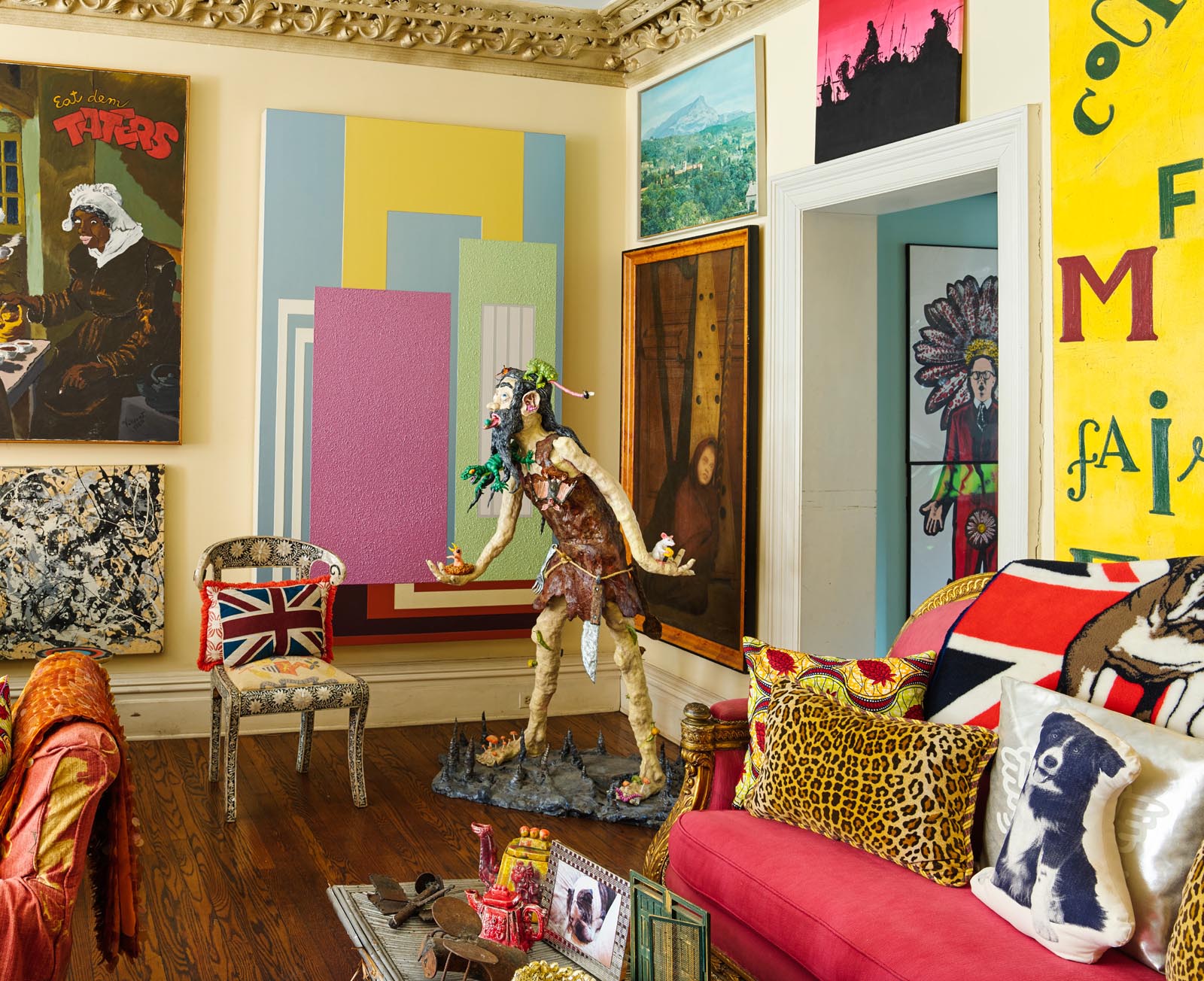
In a corner of the sitting room is a papier mâché sculpture by Theo Rosenblum. Behind, to its right, is an abstract by Peter Halley.
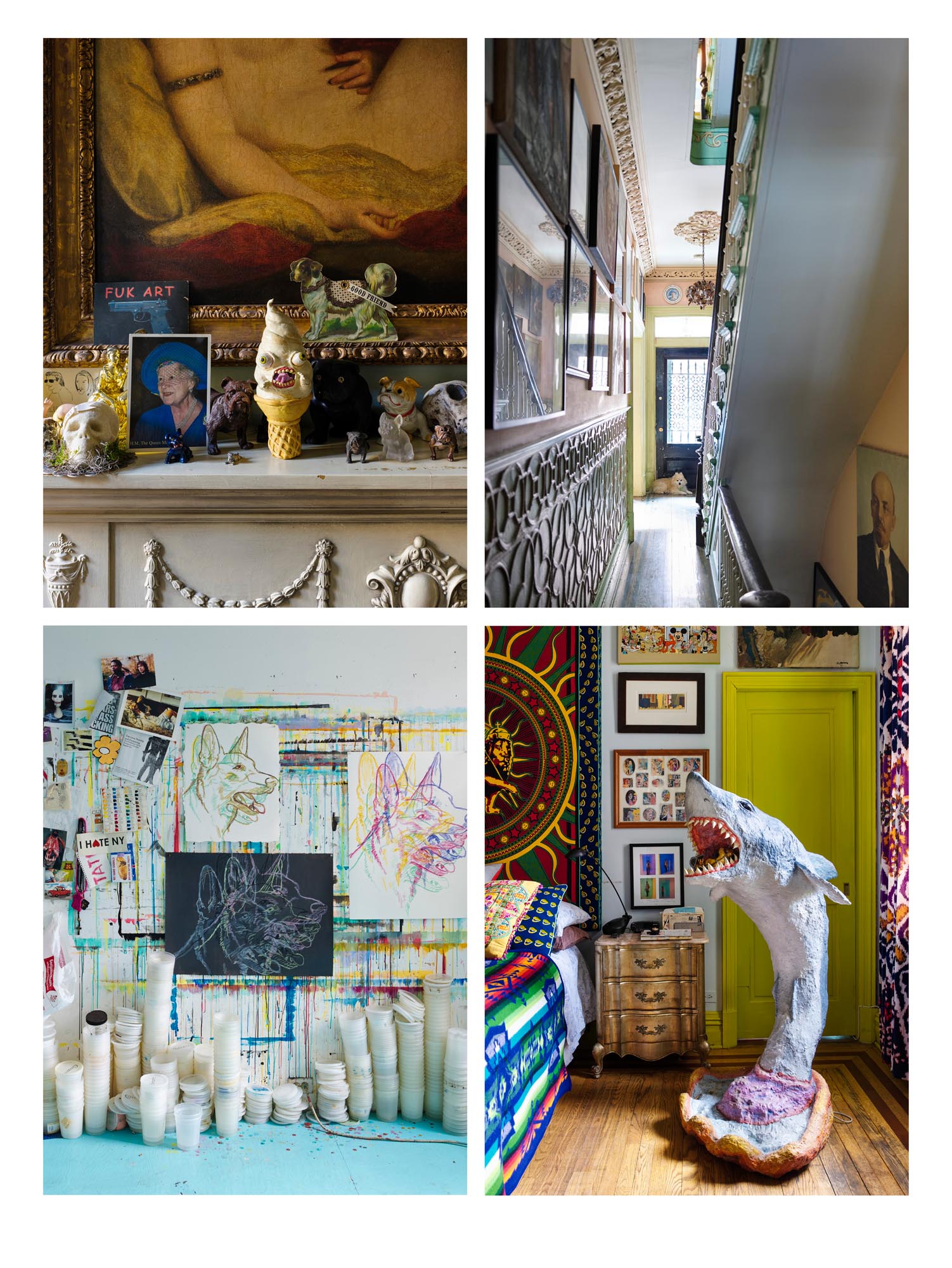
Opposite clockwise from top left: Under a glimpse of Joshua Reynolds’s painting of Venus and Cupid, the dining room mantelpiece holds a photograph of the Queen Mother and an ice cream cone figure by Theo Rosenblum. At the end of the hallway, lined with paintings, Jane’s rescue dog Cloud guards the door. A sculpture shark by Theo Rosenblum. In a corner of Jane’s studio a series of drawings reveals her passion for dogs.
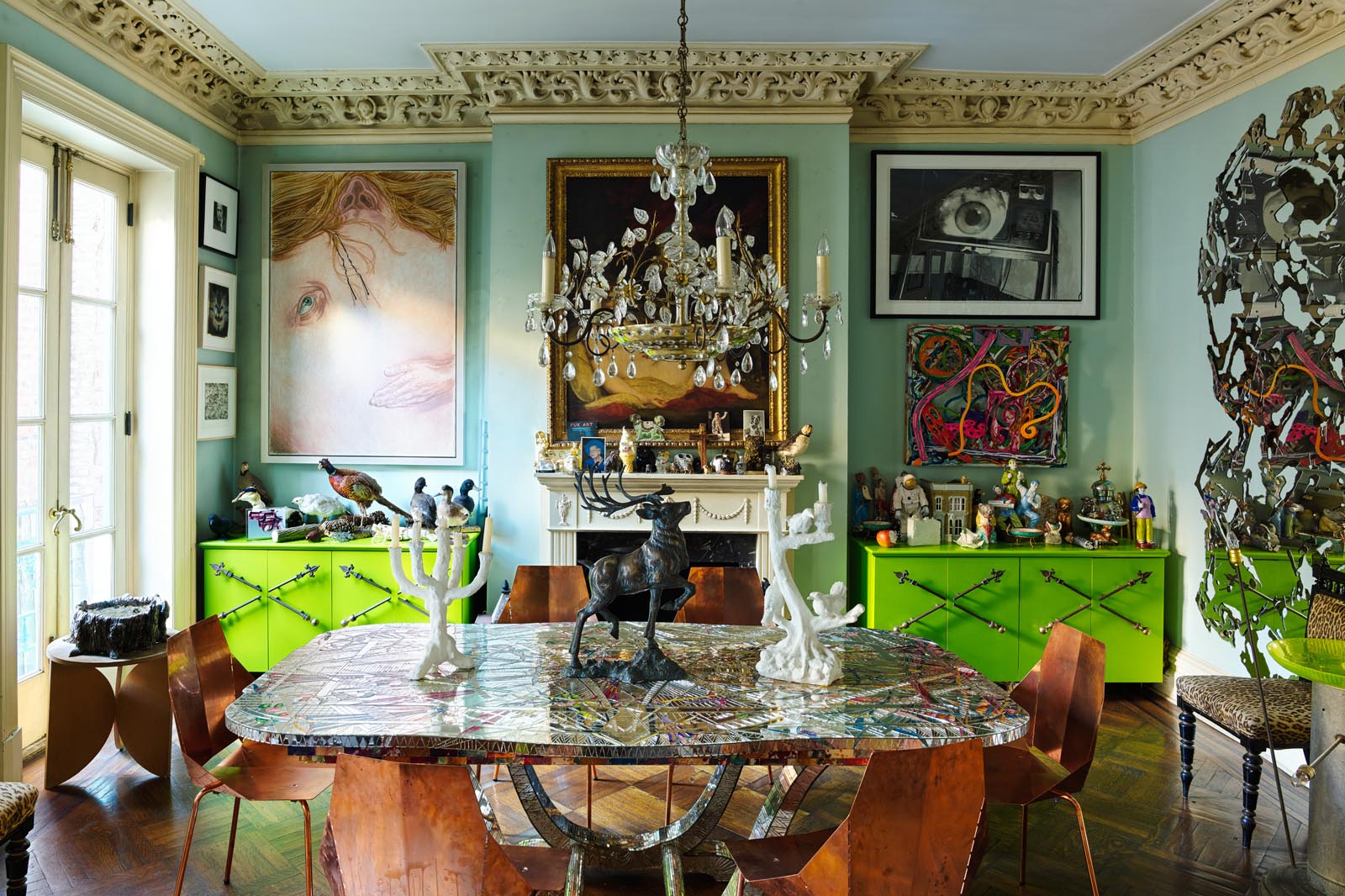
The crushed glass dining room table is by Daniel Clément. Above it hangs a chandelier Jane found in Miami. The painting on the left of the fireplace is by Alan Turner and on the right a work by Frank Stella hangs below a collage by Bruce Conner. On the wall to the right is a vast piece by Kelley Walker.
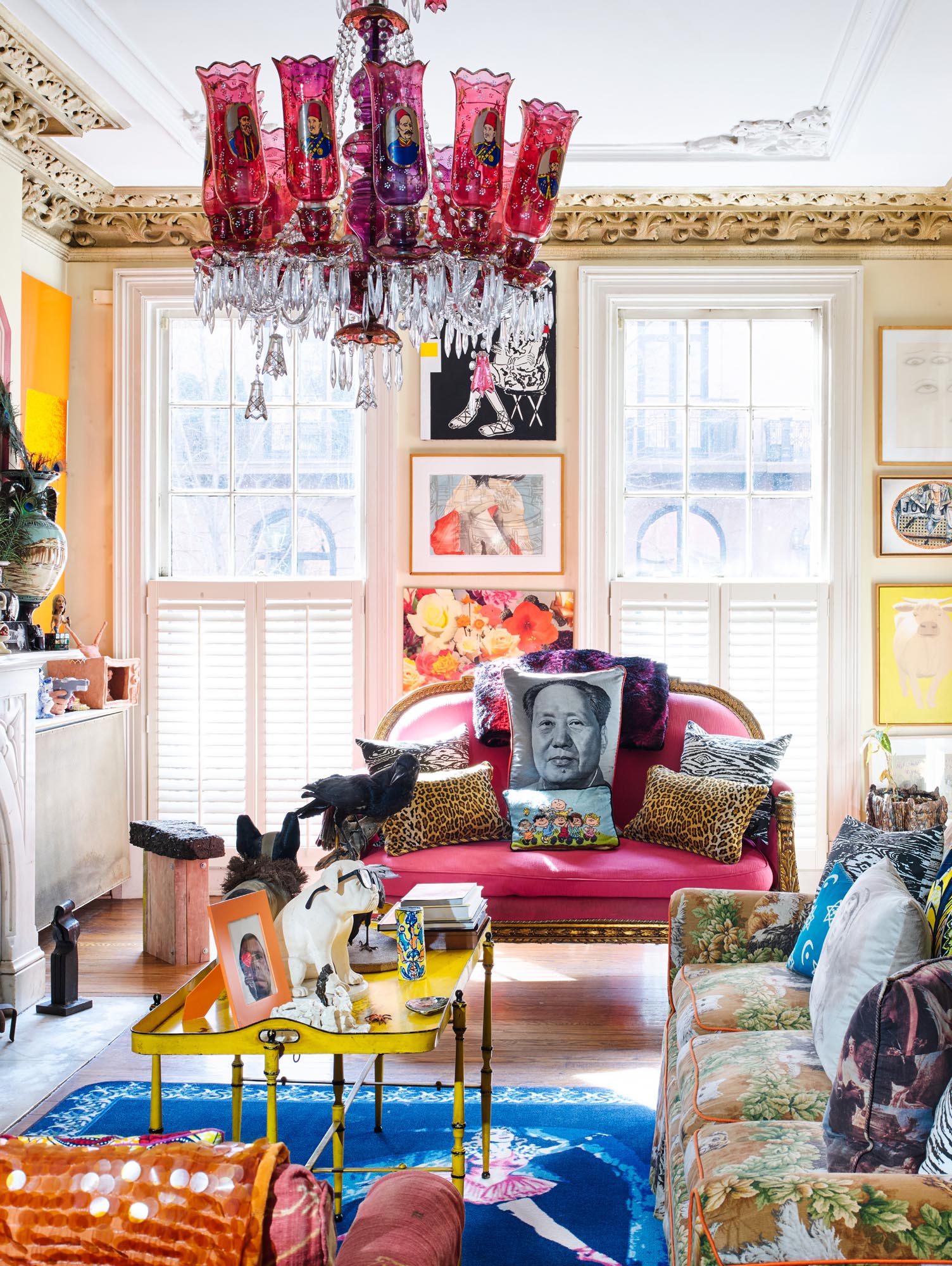
In the light-filled sitting room, a Chairman Mao cushion, made by Jane, looks at a yellow Regency-style tole table on a rug by Laurie Simmons. On the table is a little ceramic vase by Elisabeth Kley, and in front of the left-hand window is a sculpture by Klara Lidén. Above is a painted glass bulb chandelier, found in the Bowery.
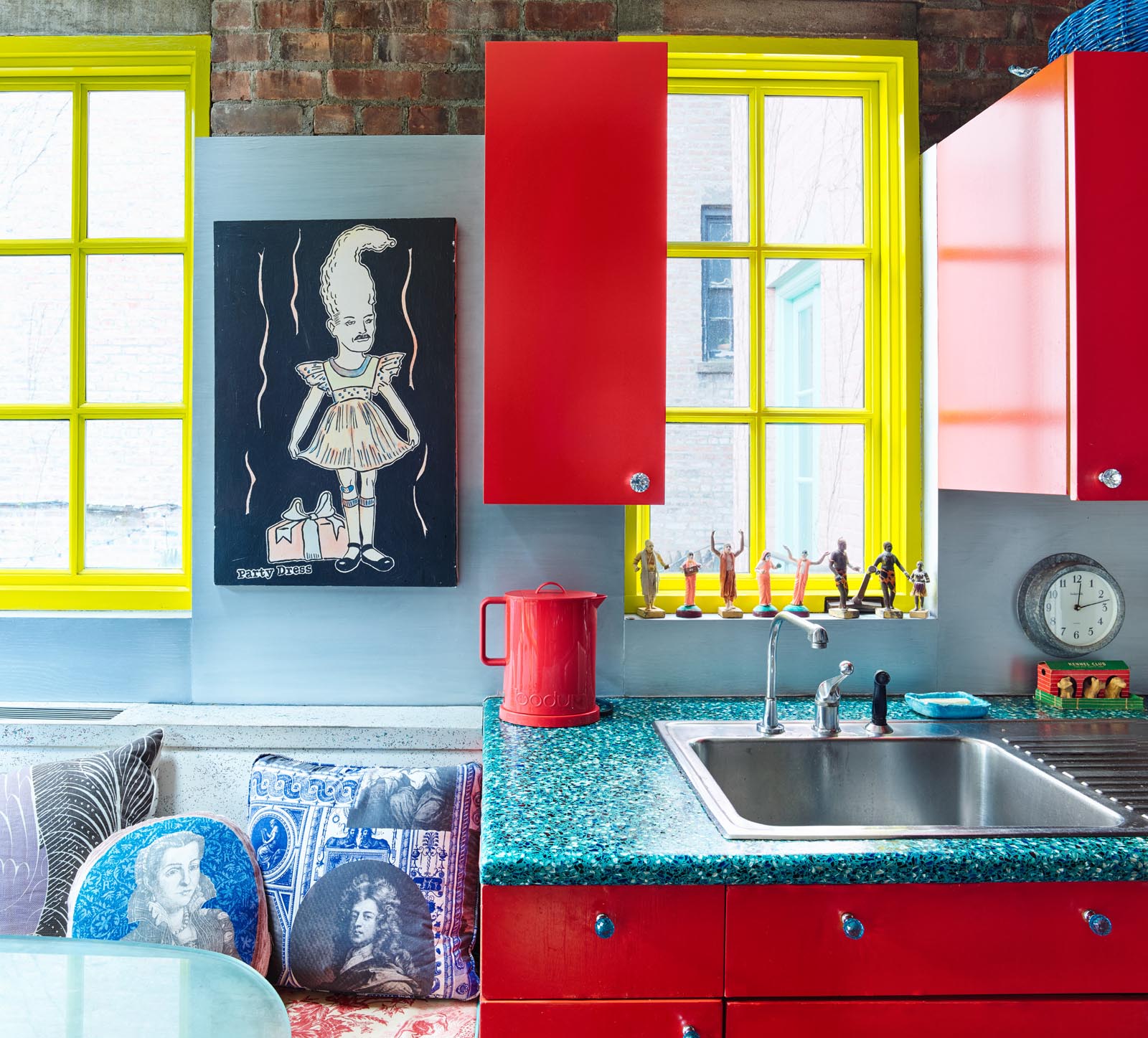
In the kitchen Party Dress, a painting by Steve Gianakos, hangs over a toile- and cushion-covered banquette. The cupboards are fronted with scarlet Formica.
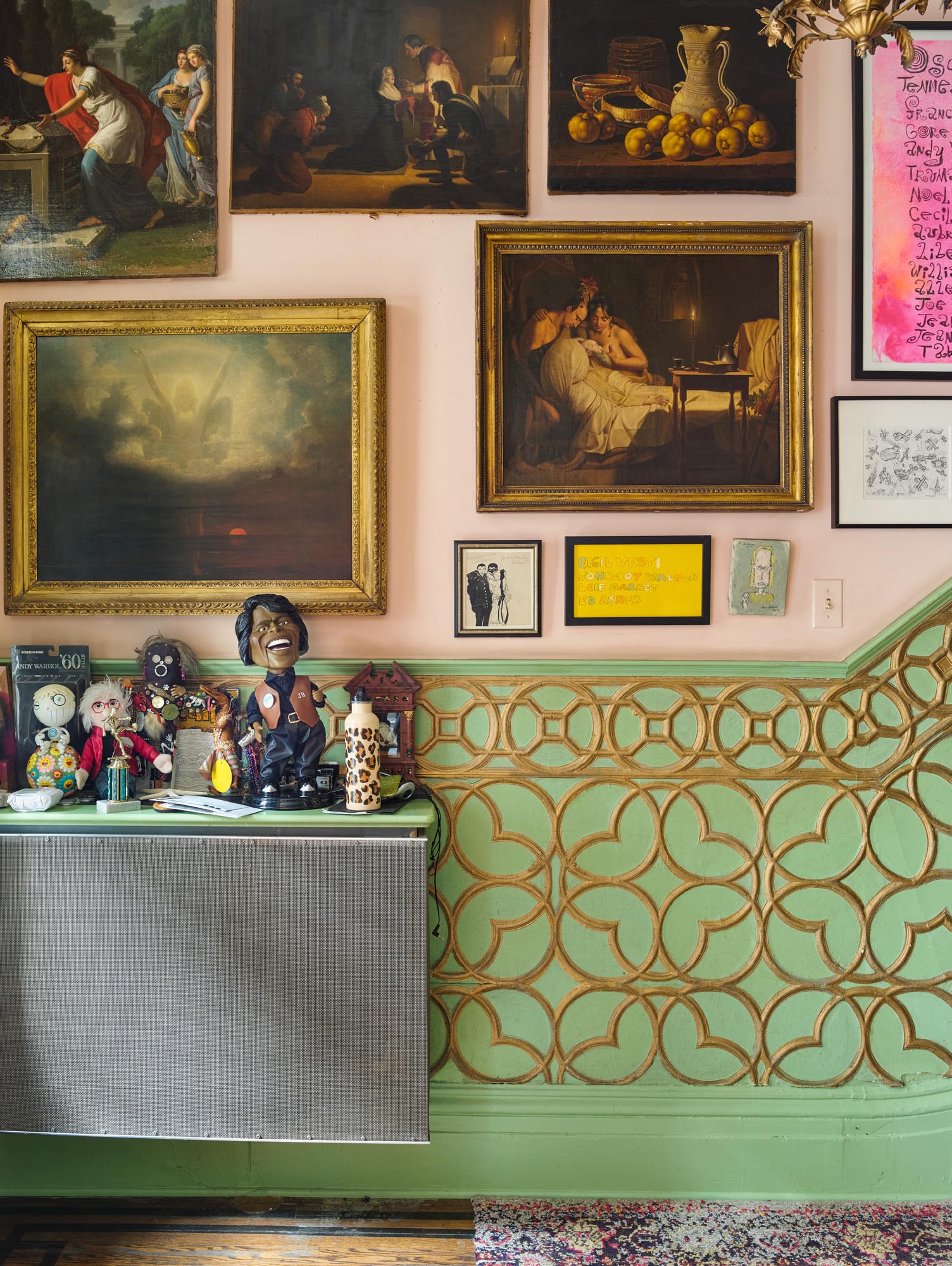
In the hallway, a cluster of typically idiosyncratic objects sit above the radiator, below a Francis Danby landscape. Above, to the right, is a still life by Luis Meléndez. The raised patterns below the dado are original, as is all the plasterwork. They were picked out and painted by Jane’s house-painters.
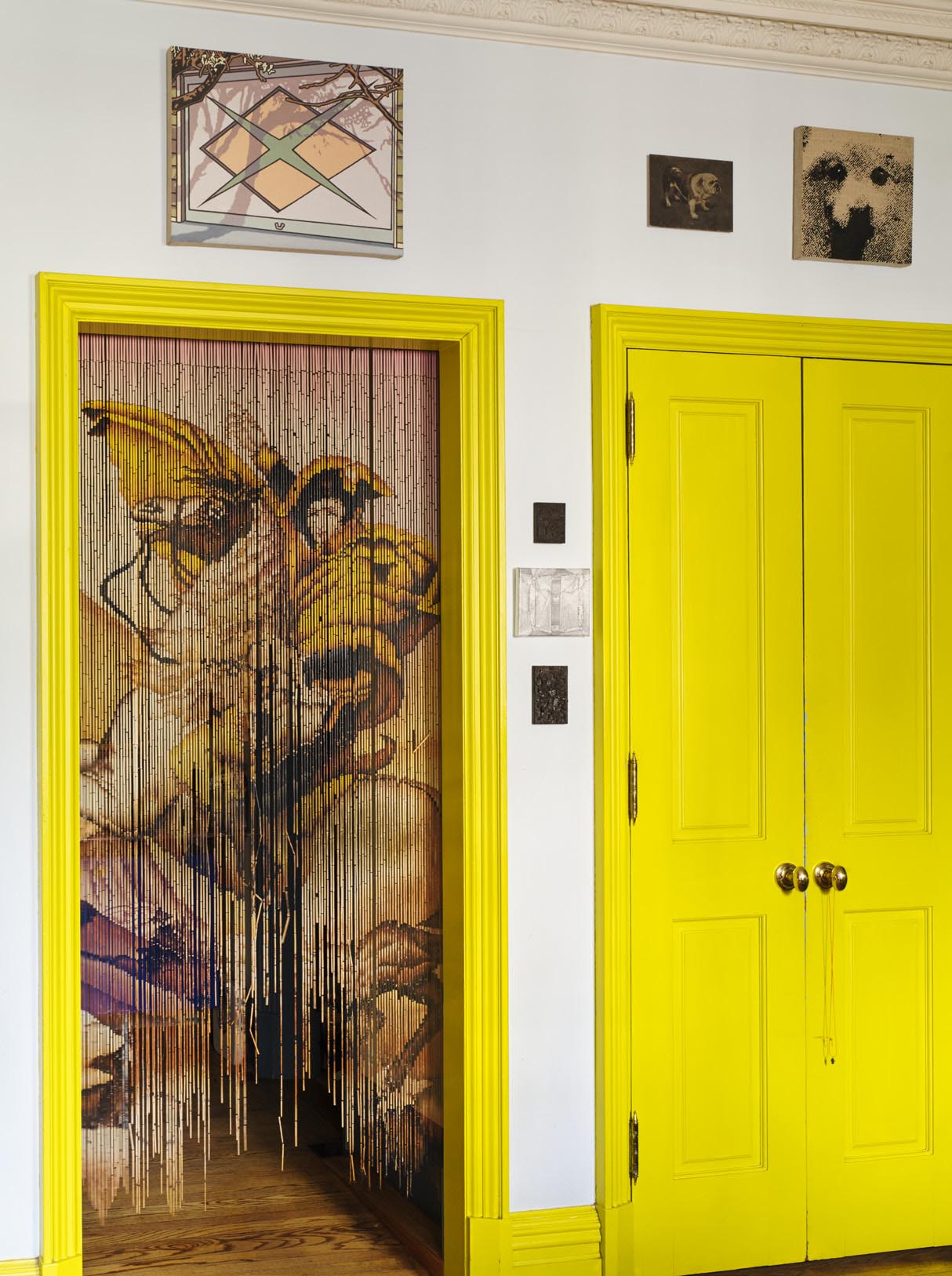
A beaded curtain is decorated with the image of Jacques-Louis David’s Napoleon Crossing the Alps.Above it is a serigraph by Jim Richard.
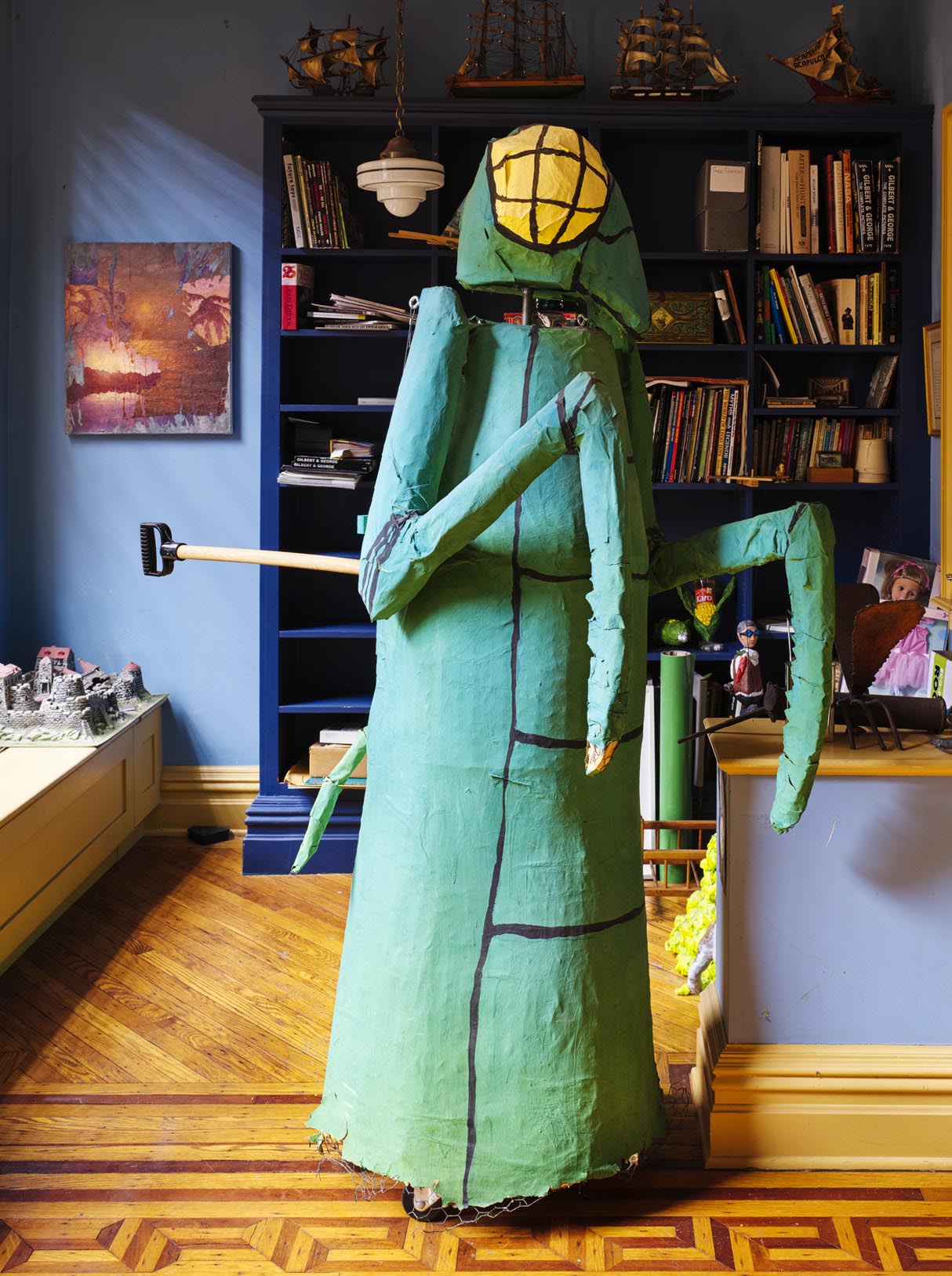
A papier mâché sculpture by Theo Rosenblum.